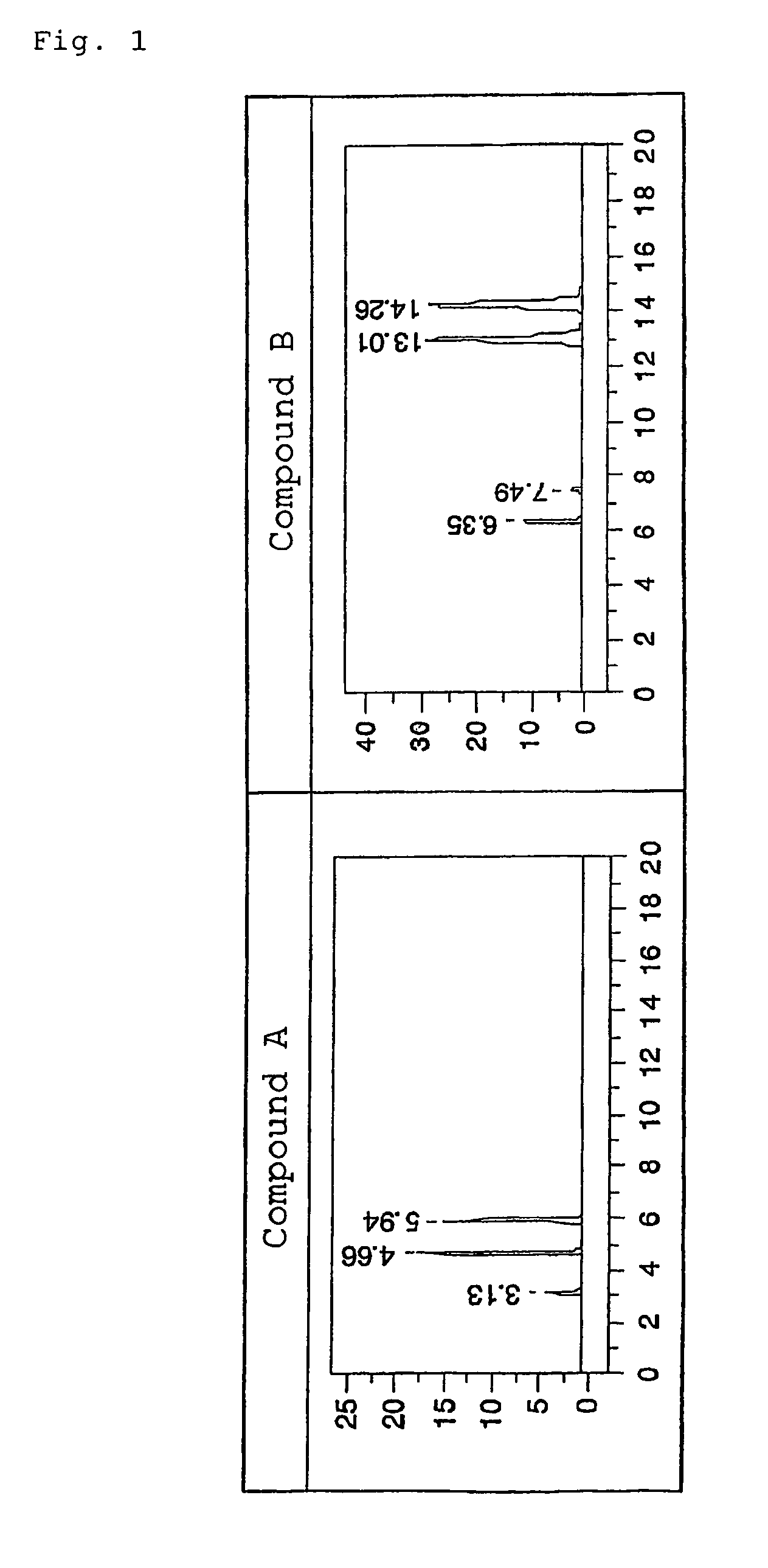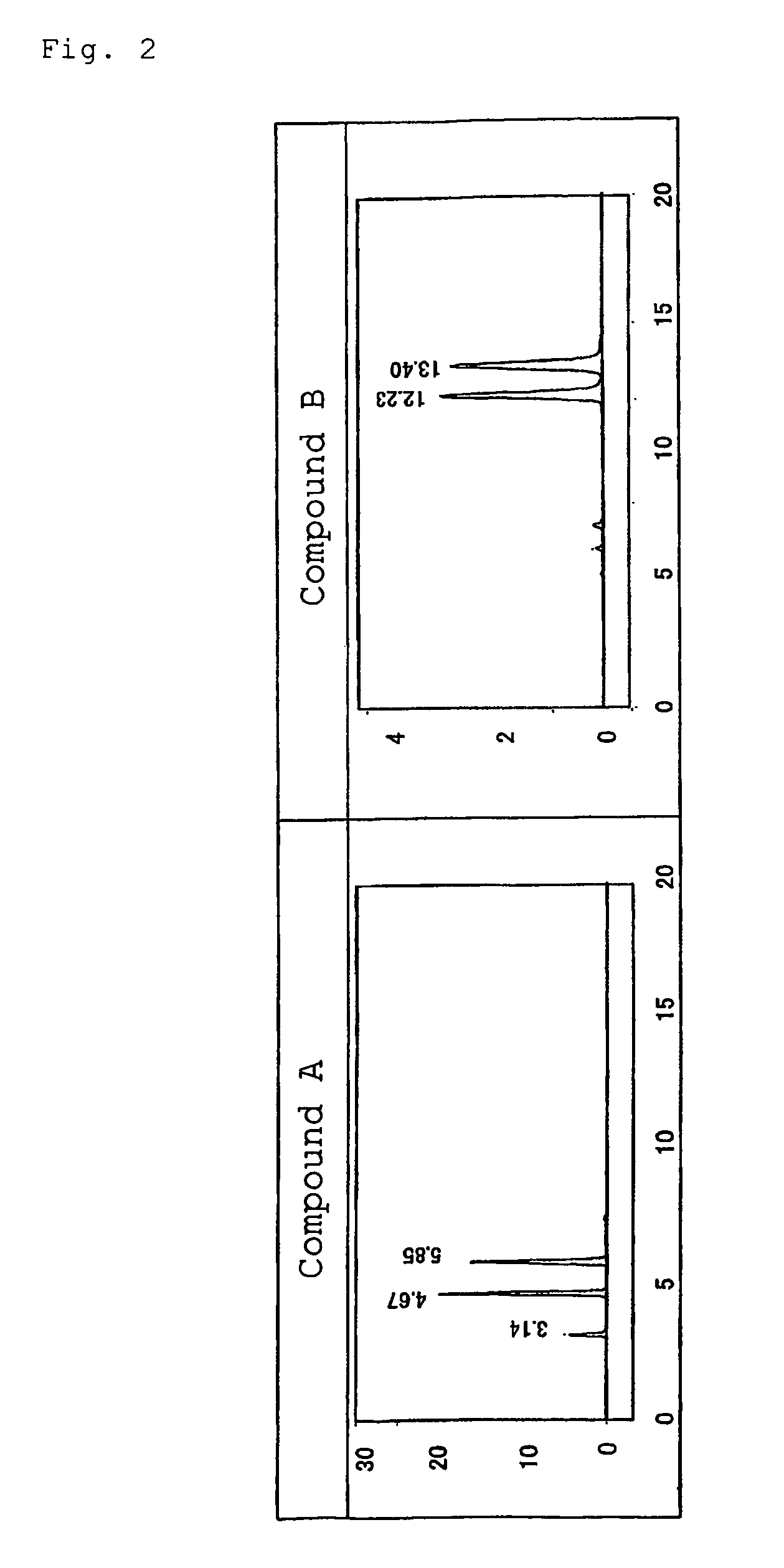Optical isomer separating filler
a filler and optical isomer technology, applied in the field of optical isomer separating filler, can solve the problems of optically active compound and serious problems, and achieve the effect of unique separating ability and separating characteristics
- Summary
- Abstract
- Description
- Claims
- Application Information
AI Technical Summary
Benefits of technology
Problems solved by technology
Method used
Image
Examples
example 1
[0053]Cellulose tris(3,5-dichlorophenylcarbamate) was produced in accordance with a known method (such as the method described in Synthesis Example 1 of Patent Document 3 (Japanese Patent Application Laid-open No. Sho 61-233633) with a change that 3,5-dichlorophenyl isocyanate was used instead of 3,4-dichlorophenyl isocyanate), and 3.0 g of cellulose tris(3,5-dichlorophenylcarbamate) thus obtained were dissolved in 30 mL of tetrahydrofuran (THF). The solution of cellulose tris(3,5-dichlorophenylcarbamate) in THF was uniformly coated onto 15 g of silica gel with its surface treated with an aminosilane (silica gel identical to that used in Example 1 of Patent Document 4 (Japanese Patent Translation Publication No. Hei 11-510193)). After that, the THF was removed by distillation.
[0054]10 g of the substance obtained by coating the support with the polysaccharide derivative by the above steps were suspended in a mixed solvent, and the suspension was stirred in the same manner as in Examp...
example 2
[0055]5.0 g (30.8 mmol) of cellulose were dissolved in 150 mL of a solution of lithium chloride in N,N-dimethylacetamide. 75 mL of pyridine and 14.4 g (76.6 mmol) of 3,5-dichlorophenyl isocyanate were added to the solution, and the mixture was subjected to a reaction at 80° C. for 6 hours. After that, 0.61 g (2.5 mmol) of 3-isocyanatepropyltriethoxysilane was added to the mixture, and the whole mixture was subjected to a reaction for an additional 16 hours. After that, 14.5 g (76.6 mmol) of 3,5-dichlorophenyl isocyanate were added to the resultant mixture, and the whole mixture was subjected to a reaction for an additional 7 hours. A pyridine-soluble portion was dropped into methanol and was recovered as an insoluble portion. After that, the portion was dried in a vacuum, whereby a cellulose derivative having alkoxysilyl groups introduced into its part was obtained. 1H NMR results showed that the introduction ratio of 3,5-dichlorophenyl isocyanate was 98.2%, and the introduction rat...
applied examples
[0067]The optical isomer separating fillers produced in Examples 1 and 2 were each loaded into a stainless column having a diameter of 0.46 mm and a length of 25 cm by a slurry method, and an analysis test for the following racemic bodies (Compounds A and B) was performed with a high performance liquid chromatography (HPLC) apparatus. Table 2 shows the results. In addition, FIGS. 1 to 6 illustrate the respective chromatograms in the applied examples. It should be noted that conditions for the analysis by HPLC were as follows: a mobile phase:hexane / 2-propanol of 90 / 10 (volume ratio), a flow rate: 1.0 ml / min, a column temperature: 25° C., and a detection wavelength: 254 nm.
[0068]In the table, α represents a separation factor, and is determined from capacity ratios represented by k1′ and k2′. The capacity ratios are determined from the following equations (1) and (2) where t0 represents the time period for which tri-tert-butylbenzene passes through the column, and t1 and t2 each repres...
PUM
| Property | Measurement | Unit |
|---|---|---|
| pore size | aaaaa | aaaaa |
| pore size | aaaaa | aaaaa |
| particle size | aaaaa | aaaaa |
Abstract
Description
Claims
Application Information
 Login to View More
Login to View More - R&D
- Intellectual Property
- Life Sciences
- Materials
- Tech Scout
- Unparalleled Data Quality
- Higher Quality Content
- 60% Fewer Hallucinations
Browse by: Latest US Patents, China's latest patents, Technical Efficacy Thesaurus, Application Domain, Technology Topic, Popular Technical Reports.
© 2025 PatSnap. All rights reserved.Legal|Privacy policy|Modern Slavery Act Transparency Statement|Sitemap|About US| Contact US: help@patsnap.com



